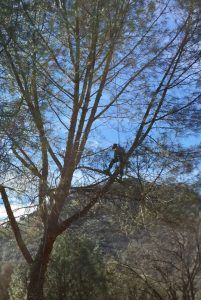To Prune Or Not To Prune

Local tree service climber prepares for his team to take down a leaning, possibly bark beetle-attacked bull pine located within the fall zone of a home. Photo by Joe Bors
Opinions in gardening are as prolific as dandelions in the spring. The same holds true for opinions about pruning. Pruning falls into several camps; never prune at all, prune to control diseases and size, or prune into geometric shapes that resemble a child’s block set. Fortunately, there is a logical reasoning to satisfy all.
Why would we prune? Basic pruning goes hand in hand with good soil, the right lighting, and good nutrition. The quality of your plants and your landscape needs those basic requirements to flourish. Just as with dandelion opinions, there are different levels to all of the above care.
To understand basic pruning, it helps to understand basic growth in plants. Plants are programmed to grow upwards, known as apical dominance. The apical dominance is controlled by the terminal bud by a constant supply of hormones. This bud is located at the tip of the stem of the branch. Those hormones keep all the lower buds in check allowing the top terminal bud to control all dominant upward growth. If that terminal bud is cut off the hormones in all the lower buds kick in and the lower buds start to grow. By removing the one top bud, growth is stimulated in multiple buds creating a bushier growth pattern.
After the hormone push, consider timing for those cuts. There are two parts to timing pruning. First is the plant itself. By making cuts on some flowering plants late in the year, you are removing your spring flowers. By pruning in the fall, especially a fall with a warm November, the plant may use those hormones to set new tender growth. New tender growth in the winter that will die back upon the first freezing temperatures.
Pruning, no matter what camp you are in, sometimes is a necessity. When a plant’s branches have died, are diseased, or damaged they should be removed. A plant that is old or overgrown may be brought back by pruning. Depending on what type of plant, a hard pruning in the spring may bring a flush of new healthy growth. Sometimes the wrong plant is planted in the wrong place. Pruning will help height and spread to create a manageable size. Who hasn’t had a bird drop a seed that sprouts and thought, “let’s watch to see what this plant might be”? Three months later it is an 18-foot butterfly bush two feet off your foundation. Pruning will control an out of control plant. Pruning out branches that cross and rub will build a plant’s structural integrity. Pruning out diseased or insect infestations all lead to better plant health.
A plant that blooms on new wood means the flowers do not develop until the new plant branches emerge in spring. The term new wood is just the new branches that will grow when the weather warms up. Good examples are roses or butterfly bushes. Old wood is last year’s branches that carry the flower buds through the winter into the following spring. Usually, old wood blooms happen earlier in spring and new wood blooms are much later.
Pruning is best done in winter. Plants are dormant with the leaves gone. It is easier to see the structure and visualize the direction the plant should grow. Pick a dry winter day for your pruning. Damp weather encourages bacteria and mold. The cold also discourages insects.
Pruning has its place in the gardener’s arsenal of care tactics. Know why and how much you are going to do before that first cut. No matter which dandelion camp you are in, keeping your plants healthy is the best choice.
Julie Silva is a University of California Cooperative Extension Master Gardener of Tuolumne County.
UCCE Master Gardeners of Tuolumne and Calaveras Counties can answer home gardening questions. Call 209-533-5912 or to fill out our easy-to-use problem questionnaire here. Check out our website here, You can also find us on Facebook.
